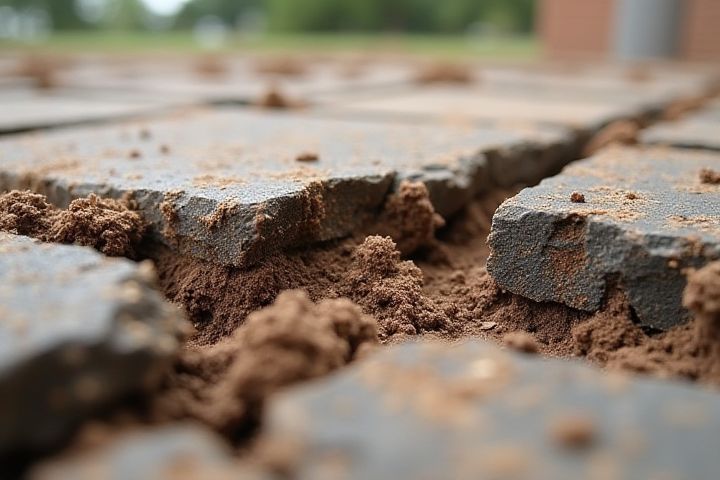
House foundation cracking can occur due to several factors, including soil settlement, moisture fluctuations, and temperature changes. When the soil beneath your foundation shifts or settles, it can lead to uneven support, resulting in cracks. Excess water from heavy rainfall or improper drainage can saturate the soil, causing it to expand or contract, further contributing to structural stress. Seasonal temperature variations can also cause building materials to expand or contract, leading to hairline fractures. Regular inspections and proper drainage systems can help mitigate these issues and maintain the integrity of your foundation.
Why House Foundation Is Cracking
Soil expansion and contraction
Cracking in house foundations often stems from soil expansion and contraction, primarily influenced by moisture levels. When soil becomes saturated, it swells, exerting pressure on the foundation; conversely, when it dries, the soil shrinks, creating gaps that can lead to settling. Clay soils, in particular, are notorious for these cycles of expansion and contraction, as they absorb water and release it, significantly altering their volume. Ensuring proper drainage and moisture control around your home can help mitigate these issues and preserve the integrity of your foundation.
Poor drainage or water accumulation
Cracking in house foundations often arises from poor drainage or water accumulation, which can lead to significant structural damage. When water pools around the foundation, the soil becomes saturated, causing it to expand and shift, exerting pressure on the foundation walls. Over time, this pressure can result in fractures, with cracks varying in size from hairline to several inches in width. Ensuring proper drainage systems, such as gutters and downspouts, can help protect your investment by diverting water away from the foundation, reducing the risk of cracking.
Temperature fluctuations
Temperature fluctuations can significantly impact the stability of your house foundation. As the temperature rises, soil moisture content decreases, leading to soil shrinkage, which can create voids and cause settlement in the foundation. Conversely, colder temperatures can cause the soil to expand, putting pressure on the foundation walls. These repeated cycles of expansion and contraction can result in visible cracks, compromising the structural integrity of your home and potentially requiring costly repairs.
Inadequate construction techniques
Inadequate construction techniques can lead to significant issues, including cracking in house foundations. Poor soil preparation, such as failing to properly compact the soil, creates an unstable base that can shift under the weight of the structure. Furthermore, the use of low-quality materials or insufficient reinforcement in concrete can weaken the foundation over time, exacerbating the risk of cracking. Understanding these construction flaws is essential for homeowners looking to identify and remedy foundation issues before they escalate into costly repairs.
Settlement of soil
Cracking in house foundations often results from soil settlement, which occurs when the ground beneath a structure changes due to moisture fluctuations, compaction, or the load of the building. This settlement can lead to uneven distribution of weight, causing cracks in walls and floors as the foundation shifts or sinks. Poor drainage systems and inadequate soil preparation before construction can exacerbate these issues, increasing the likelihood of foundation damage. Regular assessments of soil composition and moisture levels can help you identify potential problems early, allowing for timely maintenance and repairs.
Tree root intrusion
Tree root intrusion is often a significant contributor to house foundation cracking, as roots can exert immense pressure on soil and concrete structures. In particular, roots from large trees can extend 2 to 3 times the diameter of the tree's canopy, making it essential to consider proximity when planting. When roots penetrate beneath the foundation, they can create voids, leading to uneven settling and structural damage. Homeowners may notice cracks typically measuring 1/16 inch to 1/2 inch wide along foundation walls, indicating potential issues that require immediate attention.
Vibration from nearby traffic or construction
Cracking in house foundations can often be attributed to vibrations from nearby traffic or construction activities. These vibrations transmit shock waves through the soil, potentially disrupting the stability of the foundation and causing stress fractures over time. As heavy vehicles pass or construction machinery operates, soil compaction and shifting may occur, which exacerbates the risk of foundation damage. If you notice cracks forming in your home, it's crucial to assess the impact of surrounding vibrations and consider professional evaluation to maintain structural integrity.
Poor quality materials
Cracking in house foundations often results from the use of poor quality materials, which can lead to structural weaknesses. For instance, substandard concrete may have inadequate compressive strength, making it susceptible to damage from external pressures such as soil movement or heavy rainfall. Inadequate reinforcement, like low-grade steel rebar, can exacerbate this issue, allowing cracks to develop more easily over time. To ensure your foundation remains stable, it is essential to invest in high-quality materials that meet industry standards.
Climate conditions
Cracking in house foundations often arises due to fluctuations in climate conditions, especially variations in temperature and moisture levels. For instance, during periods of drought, soil can shrink, causing a decrease in support for the foundation, while heavy rainfall can lead to soil expansion and increased pressure against foundation walls. Temperature changes can also exacerbate this issue by causing materials to expand and contract, undermining structural integrity. Keeping your foundation adequately maintained and properly drained can mitigate these climate-induced risks, preventing costly repairs and ensuring the longevity of your home.
Plumbing or water line leaks
Cracking in house foundations is often linked to plumbing or water line leaks, which can lead to soil erosion and instability beneath the foundation. When water infiltrates the ground, it alters the soil's moisture content, causing it to expand and contract, putting pressure on the foundation. A mere leak of 1/16 inch can result in significant foundation damage over time, easily exceeding repair costs of thousands of dollars. Monitoring your plumbing for leaks and addressing them promptly can help maintain the integrity of your home's foundation and prevent costly repairs.
